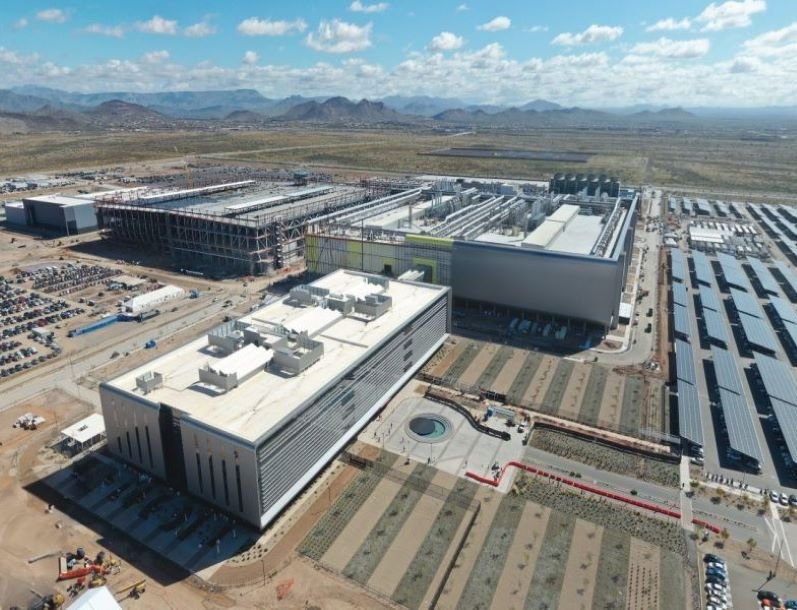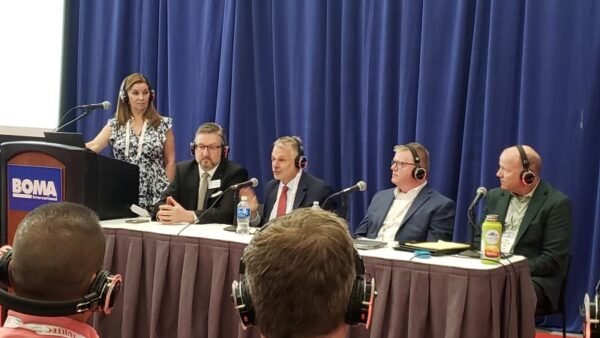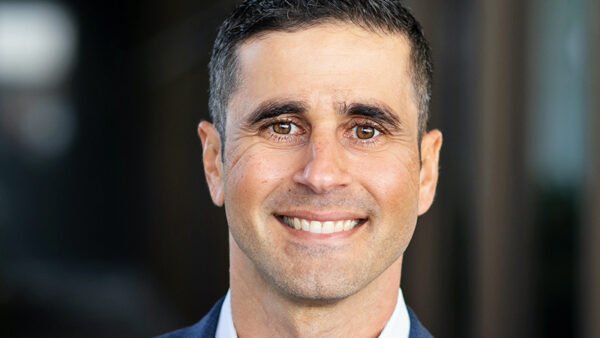Phoenix, already a top industrial and advanced manufacturing hub in the U.S., can expect to attract even more investments across all commercial real estate sectors now that Taiwan Semiconductor Manufacturing Co. plans to add a third fab for a total investment of more than $65 billion aided by direct U.S. funding of $6.6 billion under the CHIPS and Science Act.

According to a non-binding preliminary memorandum of terms signed with the U.S. Department of Commerce, the federal government also proposes providing TSMC with up to $5 billion in loans for a total of more than $11 billion in direct funding and loans. TSMC’s announcement Monday marked the largest foreign direct investment in Arizona history and the largest foreign direct investment in a greenfield project in U.S. history.
“The manufacturing push in Greater Phoenix has been building over the past decade and shows no signs of slowing down. This sustained momentum is expected to contribute to an even more diverse economy in the region over the coming decade,” said Rusty Kennedy, executive vice president, CBRE’s Capital Markets, Investment Properties, and member of CBRE National Partners, an industrial and logistics investment sales and finance platform. “When megaprojects select Phoenix, it sparks a flurry of activity in the industrial market from suppliers, distributors, third-party logistics companies, contractors and various other users that service these campuses.”
And it’s not just the industrial sector that will benefit, according to Bob Hess, practice leader & senior principal for Newmark’s Global Consulting and Strategy Solutions Group, who specializes in corporate strategy, site selection and incentive negotiations.
READ ALSO: How AI is Boosting the Data Center Market
Hess said even without the construction jobs at the TSMC site, for every job created, there should be another two created in the region. The megaproject will also result in other kinds of CRE development in the region.
“Just draw a 10- to 15-mile range around that TSMC facility and look what’s going to happen over the next five to seven years,” Hess told Commercial Property Executive. “Everybody thinks it’s all manufacturing. No, it hits every type of office, industrial, retail, housing. That’s why everybody wants these plants.”
TSMC Arizona’s three fabs are expected to create approximately 6,000 direct high-tech, high-wage jobs, building a workforce that will help to support a vibrant and competitive global semiconductor ecosystem that enables leading U.S. companies to gain access to domestically manufactured, cutting-edge semiconductor products alongside a world-class semiconductor foundry. According to an analysis by the Greater Phoenix Economic Council, this increased investment in three fabs will create more than 20,000 accumulated unique construction jobs, and tens of thousands of indirect supplier and consumer jobs.
The first fab is on track to begin production leveraging 4-nanometer chip technology in the first half of 2025. The second fab will produce the world’s most advanced 3-nanometer technology with production slated to begin in 2028. The third fab will produce chips using 2-nanometer or more advanced processes, with production expected to begin by the end of the decade.
Arizona’s semiconductor history
TSMC is not the only major semiconductor manufacturer focused on the Phoenix metro. Intel Corp., which has a long history in the state, reaffirmed its commitment to Arizona in 2021 by announcing plans to build two fabs in Ocotillo for a total investment of $20 billion. The expansion is expected to create more than 3,000 high-tech jobs along with 3,000 construction jobs. It will also likely support an additional 15,000 indirect jobs within the local community.
Other industry leaders with operations in the Greater Phoenix area include ON Semiconductor, NXP Semiconductors, Microchip Technology and others, according to Chris Camacho, president & CEO of the Greater Phoenix Economic Council.
AJ Lydon, CSCMP, executive managing director with JLL’s Industrial team in Phoenix, said the recent announcement underscores metro Phoenix’s sustained growth and leadership as a national security market and tier-one global logistics/supply chain destination.
“TSMC will be served by regional amenities including Arizona State University—the nation’s largest engineering school with more than 30,000 enrolled, 160 operating semi-conductor employers, robust demographic growth, low natural disaster risk and best-of-class infrastructure management,” Lydon said. “The region has made thoughtful, deliberate workforce/infrastructure choices over the past decade that continue to flourish.”
Hess also credited the local, regional and state governments for attracting industrial and advanced manufacturing industries to Arizona. When selecting sites for mega projects, Hess said companies go where they feel welcomed and the people will be aligned around an industry and strategy.
“I’ll tell you right now there are no issues in Arizona and Phoenix. They want the semiconductor industry and will do whatever they can to make it successful,” he said.
Hess noted everybody pulled together around these industries because they create good jobs and good economic impact. He said almost half of the high-paying jobs created will only need a high school or community college degree.
Kennedy said mega projects generate significant investments in their neighboring communities, play a role in fostering a flourishing and diverse economy, and serve as catalysts for attracting other large corporations looking for the right municipality to establish their operations.
From a capital markets perspective, Kennedy said mega campuses drive lower cap rates for industrial space located within proximity.
“This is due to increased user demand, which drives higher year-over-year rental rate growth, a lower vacancy rate, and, typically, a better credit profile. Investors want to understand the story behind what they are buying and want to know that the demand in the area is robust and that there are multiple sustainable growth drivers,” he told CPE.
Mehtab Randhawa, JLL Global Head of Industrial Research, pointed to impacts on the industrial and logistics sector.
“As semiconductor companies expand their operations in strategic logistics markets like Phoenix, it is likely to attract suppliers and partner companies to establish a presence in nearby areas. This development will drive an increased need for industrial real estate by suppliers and support services like 3PLs and trucking companies,” Randhawa said.
According to Kennedy of CBRE, North Phoenix, particularly the Deer Valley area, has benefited from TSMC’s investment at Loop 303 & I-17.
“Since TSMC broke ground on its project, Mack Innovation Park | Deer Valley, a development we lease and is being developed by Mack Real Estate Group, has experienced increased demand from manufacturers, suppliers and distributors. This activity does not account for the companies that haven’t yet been allocated funding through the CHIPS Act. Fortunately, North Phoenix and the Southeast Valley are home to various thriving subsectors of the manufacturing revolution in Phoenix, such as medical device, electric vehicle, aerospace and defense manufacturing, to name a few, and are not dependent on these suppliers and activity generated by these mega campuses,” Kennedy said.
Federal influence
In a February report published by NAIOP Research Foundation in partnership with Newmark, Liz Berthelette, head of Northeast Research & National Life Science Research at Newmark, said the confluence of the CHIPS Act, Inflation Reduction Act and Infrastructure Investment and Jobs Act represent an amount of federal spending aimed at catalyzing U.S. industrial development that has few parallels in the nation’s history.
John Leddy, managing director with JLL’s Technology Division and Semi-Conductor Manufacturing Team lead, said the CHIPS Act alone set aside $280 billion to support investment in domestic manufacturing of advanced semiconductors.
“We’re starting to see major announcements from leading semiconductor companies, with projects recently announced in Arizona, California, New Mexico, Oregon and Ohio, with the aim to increase the U.S.’s capabilities to produce 20 percent of the world’s leading-edge chips by 2030,” he said.
Intel announced last month it could receive as much as $8.5 billion under the CHIPS Act. The company also intends to claim the U.S. Treasury Department’s Investment Tax Credit—to reach up to 25 percent of investments of more than $100 billion over five years. In addition, the signed memorandum grants Intel the option to obtain federal loans of as much as $11 billion. In addition to Arizona, Intel plans to use the federal funding to develop and expand projects in New Mexico, Ohio and Oregon.
TSMC also plans to apply for the U.S. Treasury Department’s Investment Tax Credits of up to 25 percent of the qualified capital expenditure at TSMC Arizona.
In February, GlobalFoundries said it would use a potential $1.5 billion investment from the CHIPS Act to expand its Malta, N.Y., facility, including the construction of a new fab, as well as modernize its Essex Junction, Vt., facility.
Hess said the incentives provided by the U.S. government are a “leveler” to help the U.S. compete with Asia and other lower-cost areas of the world.
But at the end of the day, Hess said, “Incentives can’t make a bad location good. They’re typically tie-breakers or they’re part of a strategic investment. It takes a village. It’s not just the feds, state, local and regional [leaders]. It really has to be a partnership to make these hubs work.”





